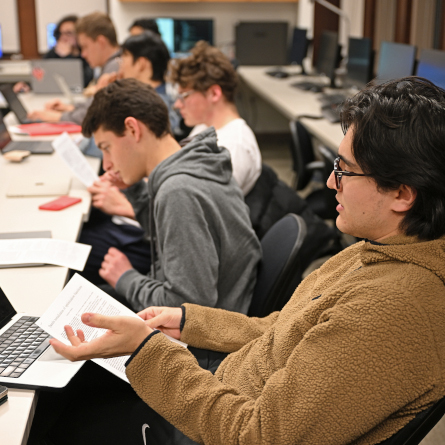
Life as a Goldfish
Richard Fay MA’68 is a world-renowned expert on fish hearing.
The goldfish. The shimmering fish that once represented good fortune and affluence is now presented as a dispensable trinket at county fairs and sold as a pet for kids. But the ubiquitous fish has also secured its place in an untold history of advancing research in bioacoustics, sonar technology and medicine.
Dr. Richard Fay’s life’s work has centered on writing this scientific history, and it all started at Conn in 1966.
Fay was alone in the lab one night experimenting on goldfish for his master’s in physiological psychology—a degree offered by very few colleges at the time—when he made a discovery that would form the core of his distinguished career in experimental psychology and bioacoustics for 50 years. At the time, psychology was the only arena in which auditory behavior could be studied, but Fay had long been fascinated by the evolutionary, behavioral and physiological aspects of hearing.
While testing the fishes’ near-field hearing abilities, Fay realized that the limbless cold-blooded vertebrates could be conditioned to respond to sounds in the same way Pavlov had conditioned dogs decades earlier to salivate when they heard a sound they’d learned to associate with being fed.
The method Fay employed used a very mild electrical stimulus while the fish were gently restrained in a tank of water. What he noticed was that the fish reflexively held their breath for a couple of seconds when they felt the stimulus. He then introduced sound to the experiment, placing a speaker under the tank and playing a repetitive tone at the same time he activated the electrical current.
After repeating this a few times, Fay removed the electricity and was still able to generate the same pause in breathing by only playing the sound. The fish had been conditioned to associate that specific tone with the electrical stimulus, even in its absence, and display the same physical response.
Although Fay also went on to study oyster toadfish (one of the less outwardly beauteous inhabitants of the deep), goldfish have always been his primary research subjects. As he recalled to a conference audience in 2013, Fay first chose to experiment on goldfish out of sheer convenience.
“Originally, I used them for all the wrong reasons,” Fay said. “They were a nice size of about six inches, and I could get them at Woolworth for 50 cents. It turned out they were perfect for my research, because they aren’t able to make sounds like some other fish can, but they still hear.”
Fay’s conditioning method with goldfish opened the door for more sophisticated experimentation that examined how fish hear, how sound travels under water and what types of applications this research could have in human medicine, behavior and technology.
Fish offer insight into how vertebrate hearing has evolved over hundreds of millions of years, and how the brain processes and perceives sound. And although fish don’t have outer ears, they do have inner ears and are able, Fay found through his research, to distinguish between pitch and frequency and can filter and segregate different sounds simultaneously, the way we can hear the different instruments in a symphony, for example. Without this evolutionary survival skill animals wouldn’t have much use for hearing at all, since the auditory system would be rendered practically useless whenever more than one sound at a time was present.
Fay has said that this ability to segregate sounds is something scientists are trying to recreate in artificial intelligence, and the work he and his colleagues have done to better understand fish hearing may well help advance that type of research. Solving that puzzle could dramatically improve basic technology we use on a regular basis.
“Currently, if you are on the phone using a voice-activated customer service program, it will understand you when there is one, clear sound,” Fay explained. “But if there’s background noise, it will fail, because it can’t sort out the sounds and prioritize them the way human ears can.”
But long before artificial intelligence was part of our daily lives, Fay’s early research showed the potential to advance technology.
In 1968, with the Cuban Missile Crisis a nagging memory, and the war in Vietnam escalating, the U.S. Navy began exploring bioacoustics in ways that could inform its research and development efforts relating to sonar technology and underwater communications. Fay was a perfect fit for this avenue of inquiry, and began doing research for the submarine base in nearby Groton while he finished his master’s at Conn.
After moving on to complete his Ph.D. in experimental psychology at Princeton University, Fay got an unexpected offer from the Laboratory of Sensory Sciences in Honolulu.
By then, married to Catherine Hill Fay MA ’67 and with a two-year-old son, Fay asked his wife if she’d be at all interested in moving from New Jersey to Hawaii. Five weeks later, the Fays had sold their cars and furniture, and were settled into a house with a panoramic view of Waikiki Beach. Their backyard was lush with mango and passion-fruit trees, and Fay was working with Georg von Bekesy, who had won a Nobel Prize for his breakthrough research involving the cochlea and inner ear. Life was very good, but after a few years, the mainland came calling again.
So in 1974, trading the tropical environs of Hawaii for the chilled winds of Chicago, Fay joined the psychology faculty at Loyola University, where he would spend the remainder of his career until he retired in 2011, rising to become the director of the Parmly Hearing Institute and a beloved professor.
Beginning in the early 1990s, Fay branched out beyond aquatic species exclusively, and became a co-founder and editor of the Springer Handbook for Auditory Studies, which continues to serve as an indispensable guide to the next generation of scientists, physicians, biologists and biomedical experts.
Diana Ma, a former graduate student of Fay’s who founded and serves as the executive director of the Richard R. Fay Foundation, which works with scientists around the world to consolidate and share biomedical research, said Fay’s legacy would be felt for generations to come.
“Dick is really the father of this type of research and his work set the foundations for ... advances in the fields of sensory biology, perception and neuroscience,” Ma said. “Most of the major fields of auditory research today are built on the science Dick was responsible for throughout his career, and the Springer Handbooks are on every shelf of every person in these fields.”
After devoting his life to better understanding how animals hear, Fay and his wife finally settled into retirement in Woods Hole, Massachusetts where he spent many summers conducting research at the esteemed Marine Biological Laboratory. Having made such an extraordinary impact on his graduate students over the years, Fay is now determined to impart his wisdom to young kids. He’s currently working on a children’s book that explains the science of hearing in more accessible terms.
The hero of the story is a goldfish.

